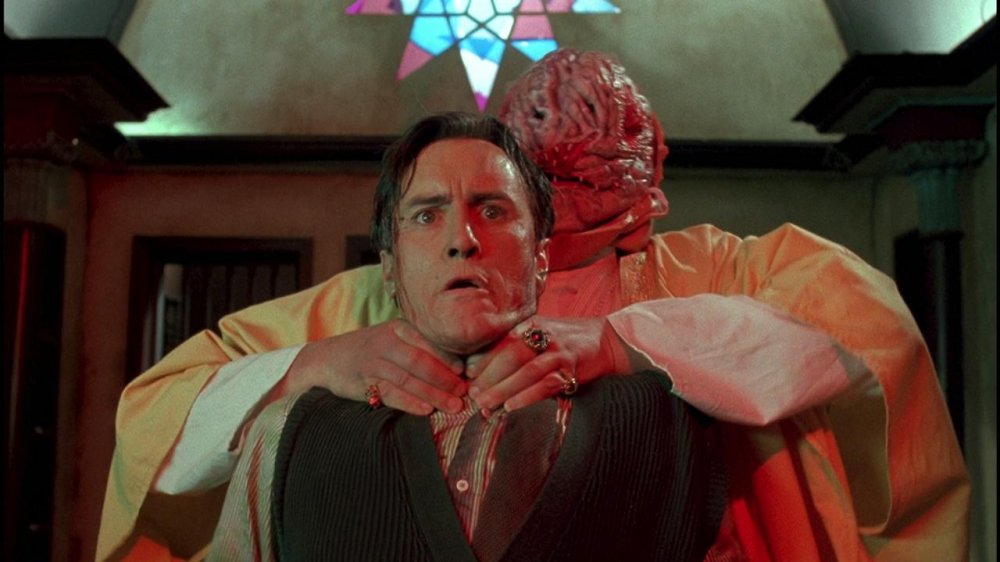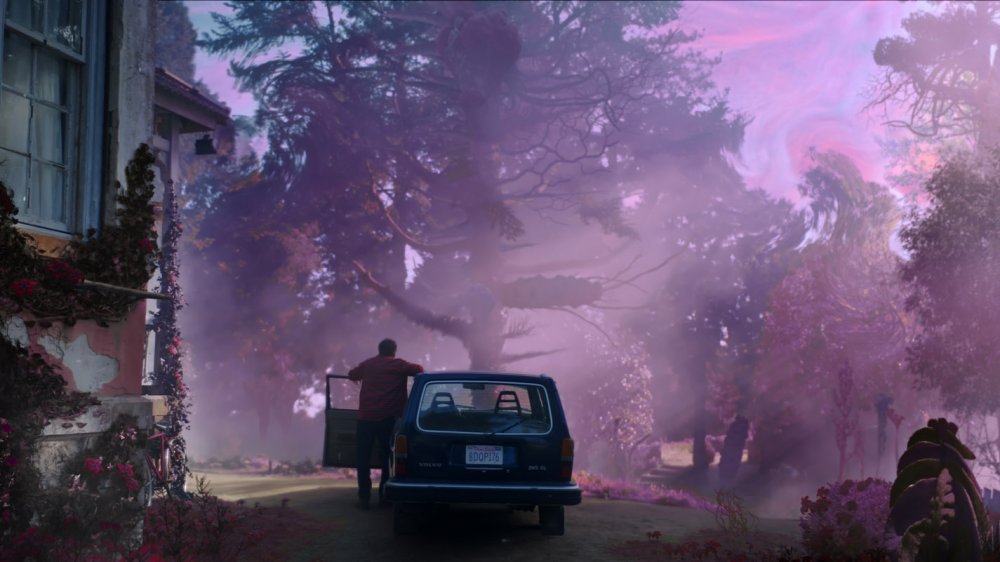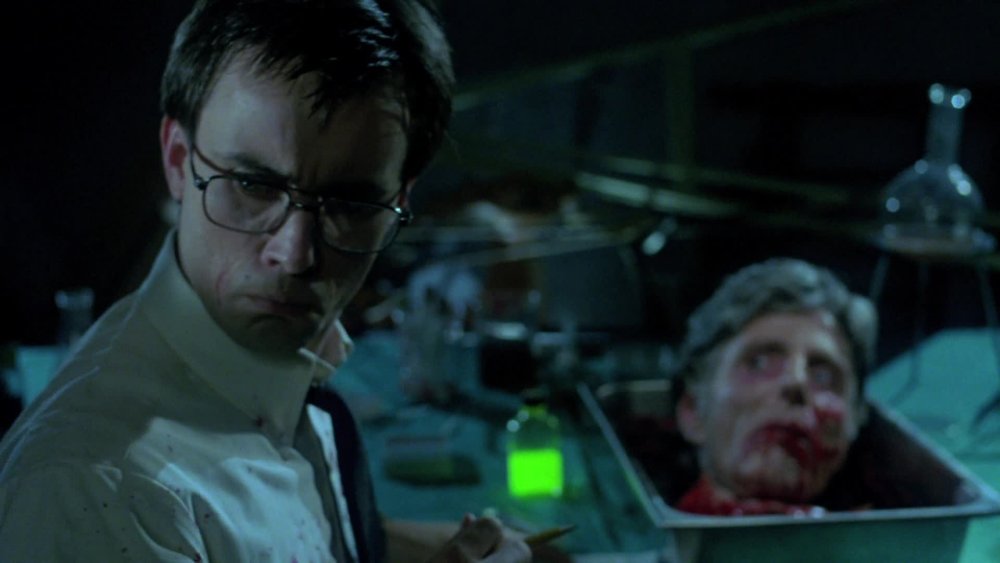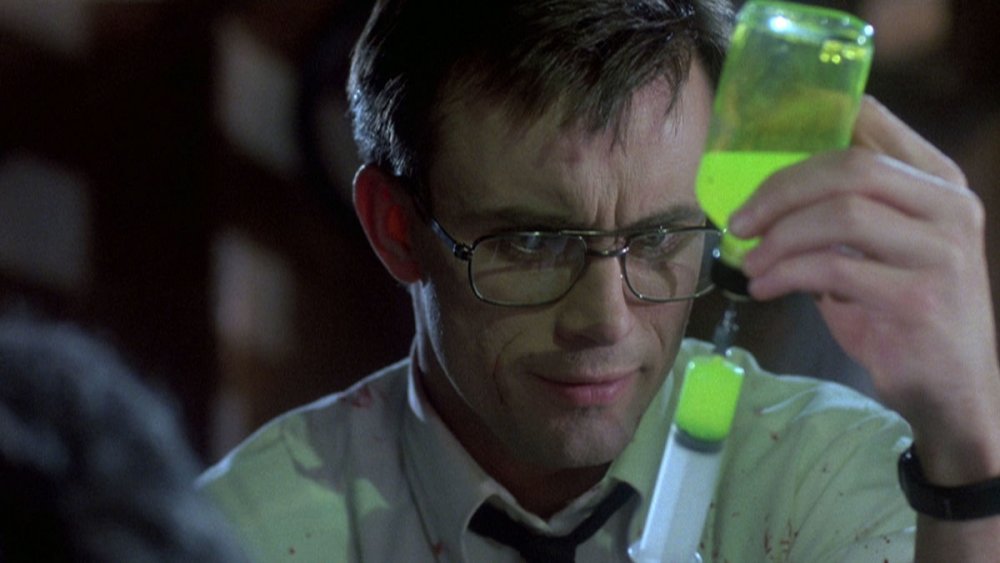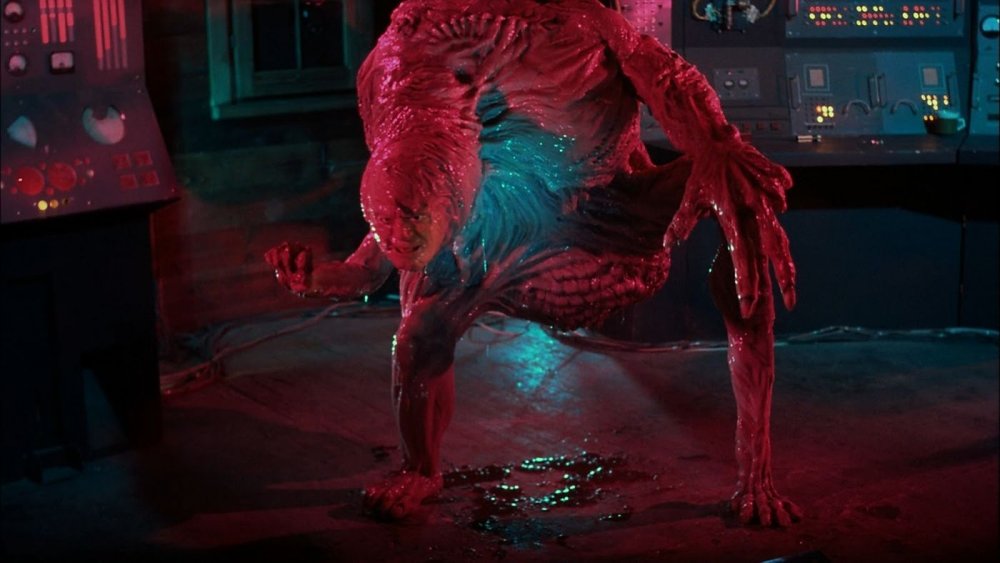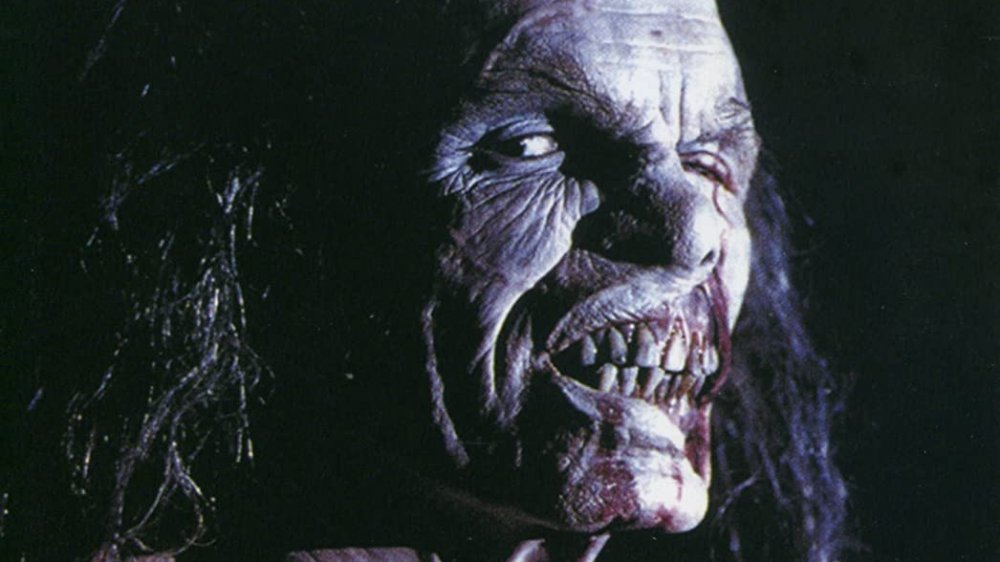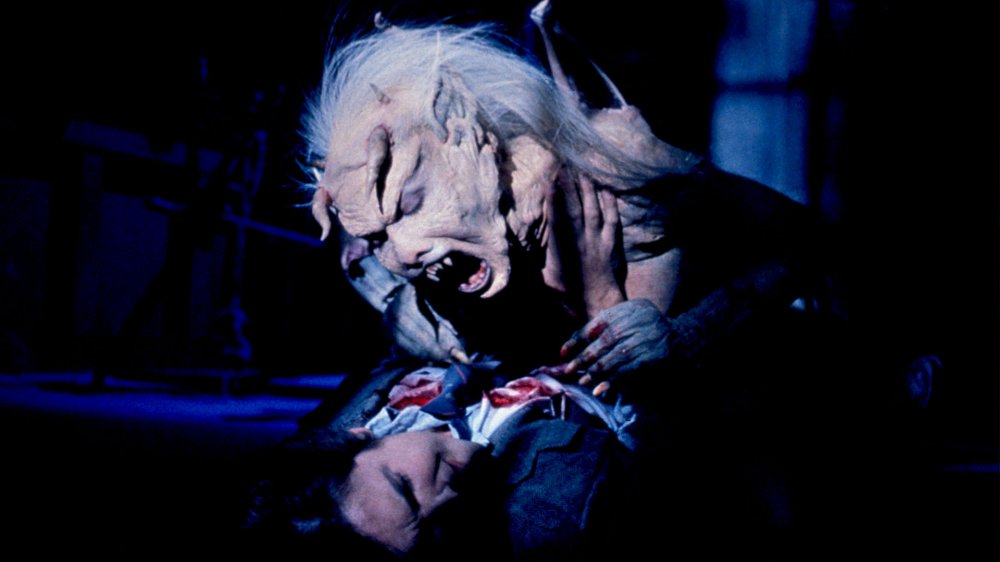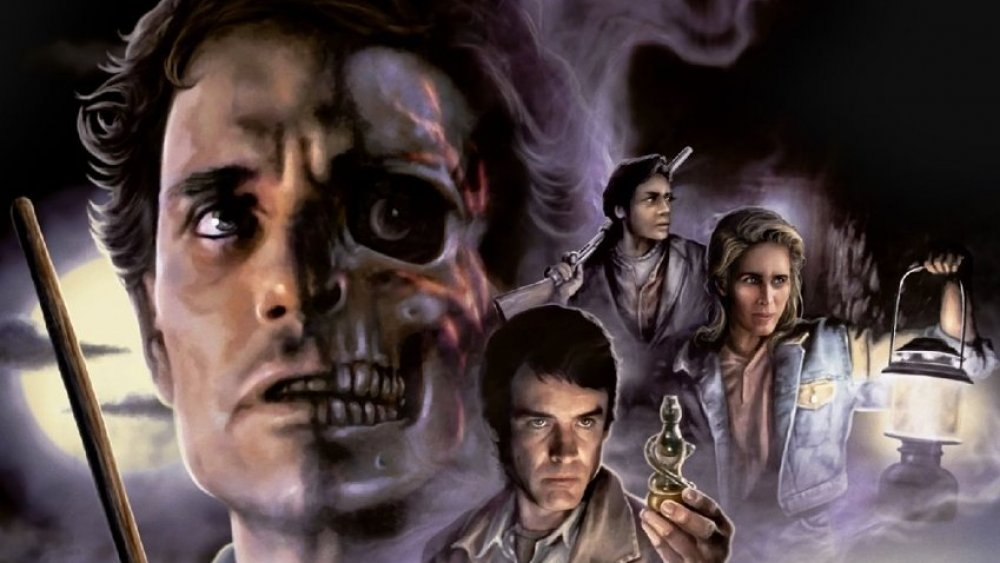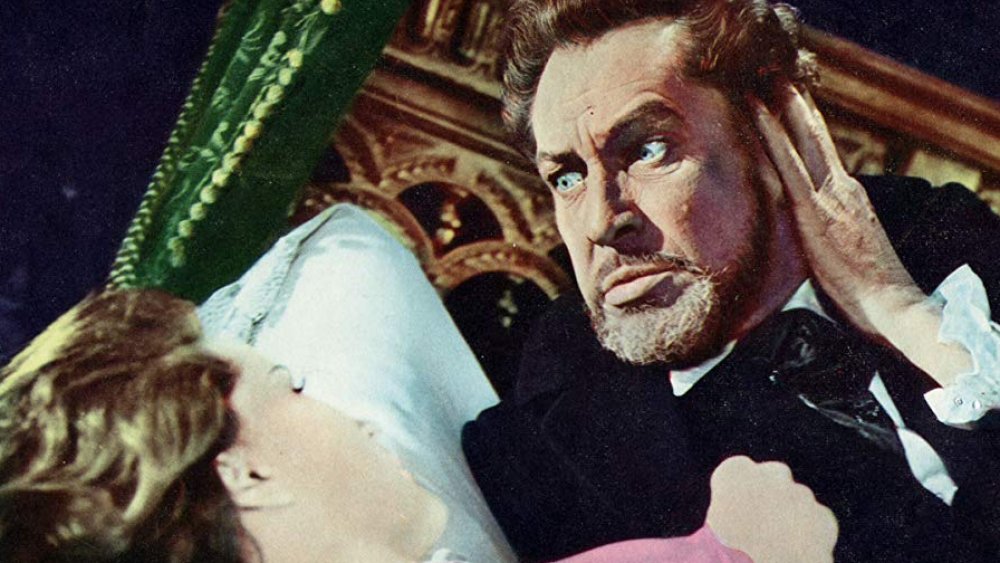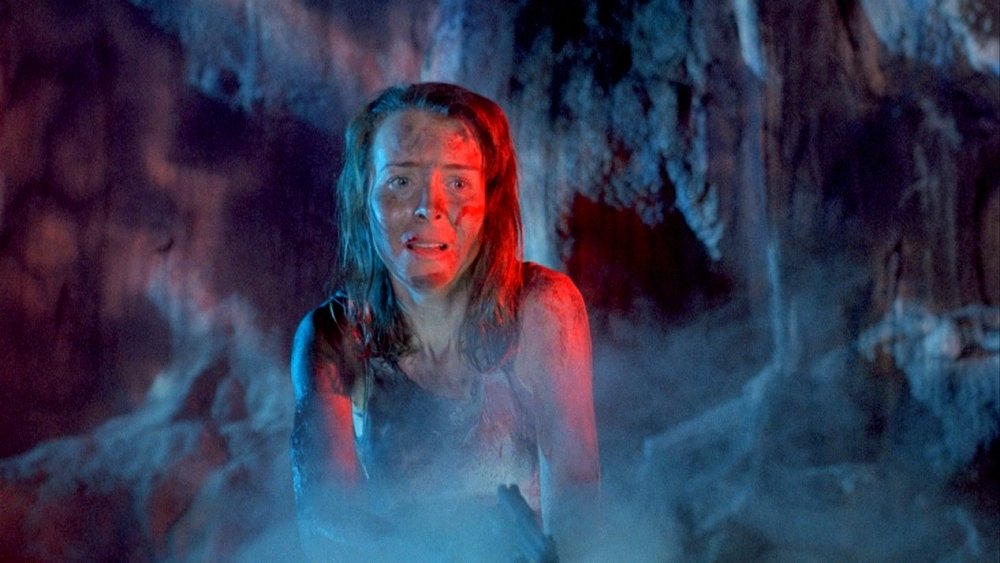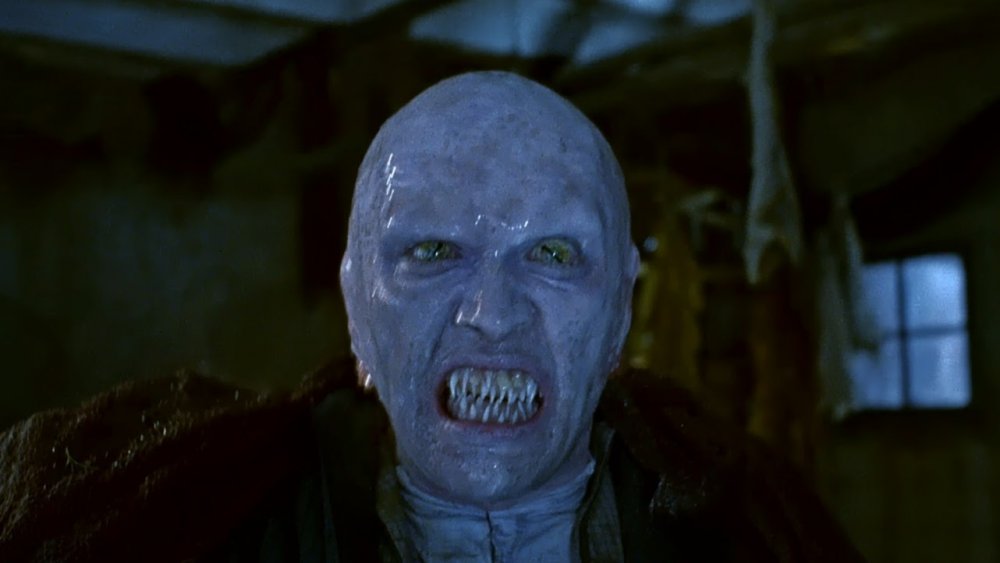The Best Movies Based On H.P. Lovecraft Stories
Lovecraftian. It's a term you likely often hear when someone describes a certain brand of horror, but what exactly does it mean? For those not aware, the term was derived from the name of American author H.P. Lovecraft. Often referred to as "cosmic horror," the Lovecraftian horror genre predominantly focuses on the concept that mankind is an insignificant speck of dust in the universe. It's the idea that some unforeseen threat or some thing, whether it's from outer space, another dimension, or sometimes beneath our very own feet — perhaps an ancient deity from somewhere in the unexplored depths of the ocean — could present itself at any time and we would be defenseless and unable to comprehend these unnatural occurrences or otherworldly forces. Quite simply, Lovecraft explores the fear of the unknown.
There's no doubt that the writings of Lovecraft have influenced artists, authors, and filmmakers for decades. Artist H.R. Giger — the artist who created the space creature from Alien — named one of his art books after the Necronomicon, a black magic book that often appeared in Lovecraft's writings. Horror author Stephen King once said that Lovecraft "opened the way for me." Director Guillermo del Toro, a self-proclaimed super-fan, once tried to adapt At The Mountain of Madness with James Cameron attached as a producer and superstar Tom Cruise in a lead role. The project had Lovecraft fans salivating, but was scrapped when the studio got cold feet about the R rating. Let us all pray to Cthulhu that Del Toro's dream project gets back on track one day. Speaking of Cthulhu, which is one of Lovecraft's most famous mythologies, catch the tail end of Underwater starring Kristen Stewart and you might recognize an awfully familiar tentacle-faced leviathan.
Lovecraft's influence is everywhere. The British Film Institute agrees that films such as Ridley Scott's Alien and Prometheus, Alex Garland's Annihilation, and John Carpenter's The Thing and In The Mouth of Madness all exude heavy Lovecraftian vibes. Next up is HBO's Lovecraft Country, based on the novel of the same name by Matt Ruff. The themes explored in the show have the legendary author's fingerprints all over them. During the past 50 years or so, there have been dozens of adaptations of the man's work. In particular, the 1980s and 1990s delivered some of the best and most well-known movies based on his writings. Here's a look at some of the most notable Lovecraft adaptations that are worth your time and pennies.
Color Out of Space
Based on Lovecraft's short story of the same name, Color Out of Space is a cosmic horror tale about the strange occurrences that follow when a meteorite crash lands in the front yard of the Gardner family farmstead. Nicolas Cage stars as Nathan, a father who is obsessed with growing tomatoes and raising the family's alpacas, and Madeleine Arthur as Lavinia, his Wiccan daughter who has a serious interest in the occult. One night, in what at first seems to be a tremor, their farm is rattled while drenched in an unearthly luminous light as a meteorite enters the atmosphere and strikes their front lawn. Nathan describes it as "A color I've never seen before." As the family investigates the crash site, there is an eerie magenta-like glow pulsing from beneath the ground.
It's not long before things start getting really weird: Bolts of lightning randomly strike the meteorite's landing spot, strange fluorescent-colored flowers and vegetation blossom around the farm, mutated insects appear, electronic devices go bonkers, Nathan experiences severe mood swings, and the Gardners' youngest son Jack (Julian Hilliard) becomes fixated with the front lawn's water well and claims to hear voices. Things spiral into utter chaos when an unexplainable force mutates the alpacas into a deranged monstrosity that looks like it walked off of the set of John Carpenter's The Thing — but it's not the alpacas who suffer the worst fate. Expertly directed by Richard Stanley and accompanied by yet another signature mad-eyed performance by Cage, Color Out of Space is oozing with not only lurid practical effects, but also makes a lasting impression with its visual style and some truly nightmarish sequences.
Re-Animator
Arguably one of the most famous Lovecraft adaptations, the late Stuart Gordon's 1985 cult classic Re-Animator offers a modernized (and delightfully twisted and perverse) take on the serialized short story "Herbert West—Reanimator." The first of five Lovecraft adaptations that Gordon would direct throughout his career, Re-Animator introduces us to medical student Herbert West (Jeffrey Combs), who has a reputation for conducting dubious experiments with horrific side effects — he was accused of killing his professor when he in fact brought the man back to life, claiming a wrong dosage caused the experiment to fail. Fast forward to some time later, and West is now continuing his studies at the Miskatonic University in Arkham, Massachusetts. (Fun fact: Miskatonic and Arkham both appear in numerous Lovecraft stories as well as their movie adaptations). While there, West meets up with new roommate and fellow student Dan Cain (Bruce Abbott) and converts their basement into a laboratory.
West soon lets Cain in on the past controversial experiments surrounding his secret reagent that reanimates the dead. To prove this, he demonstrates by bringing a dead cat back to life. Cain quickly becomes just as obsessed with the reagent as West, and the two move up from cats to actual human cadavers stored in the University's morgue. As you can imagine, undead hell breaks loose. Re-Animator is loaded with dark humor, over-the-top gore, demented practical effects, and even some sexually charged horror. Let's just say there's a scene involving the decapitated villain Dr. Hill (David Gale) examining a strapped down Megan (Cain's fiancée, played by Barbara Crampton) with his very own severed head — it's something you simply cannot unsee.
Bride of Re-Animator
Five years after Re-Animator hit theaters, horror fans were gifted with Bride of Re-Animator. Director Stuart Gordon sat this one out, but original producer Brian Yuzna stepped in to take the helm, Jeffrey Combs once again reprised his role as West, and Bruce Abbott returned as Dan Cain. Lifting elements from the final two volumes of Lovecraft's serialized short story "Herbert West—Reanimator," the sequel finds West and Cain continuing their experiments eight months after the events of the first film. West discovers that his reagent can not only revive dead bodies, it can also reanimate severed body parts. This leads to his bright (and bad) idea to go all Doctor Frankenstein and build a living body from random parts. Spoiler alert — one of those parts is Megan's heart, left over after she seemingly perished following the first film's final scene.
As if the title of this movie wasn't already a dead giveaway, you can see where this is going. West reassures the heartbroken Cain that they can build a new Megan from scratch and as usual, madness ensues. Bride of Re-Animator may not be as good as the original, but it is equally as amusing with its dark humor, memorable performances by the original cast, and a purely bonkers finale. For you completists out there, Yuzna made a third and final installment of the franchise with 2003's Beyond Re-Animator. Combs returns for the third outing, but unlike its predecessors, it isn't based on any of Lovecraft's stories except for the fact that it features Herbert West.
From Beyond
Re-Animator vets Stuart Gordon, Jeffrey Combs, and Barbara Crampton reunited for 1986's From Beyond. As he did with Re-Animator, Gordon updated the story to a contemporary setting. Combs plays Crawford Tillinghast, a scientist who assists Dr. Edward Pretorius (Ted Sorel) with his latest invention, the Resonator — a machine that stimulates the pineal gland of the human brain, causing one to develop a sixth sense that, once activated, allows humans to see beyond our plane of existence and into a parallel dimension.
Of course, there are malevolent oddities and creatures that exist in this realm. The first experiment ends with Pretorius literally losing his head. Tillinghast is accused of murder and deemed insane and hauled to a padded cell, but psychiatrist Dr. Kameron McMichaels (Crampton) believes Tillinghast's story — and the only way to prove he's not totally insane is to reactivate the Resonator. In doing so, they unleash the severely disfigured and mentally distorted Pretorius, who has diabolical plans of his own. Filled with fascinating concepts and imaginative creature designs, From Beyond is another wild romp from Gordon and his creative team, who once again go nuts in this gooey practical effects powerhouse.
Castle Freak
Director Stuart Gordon's third venture into the world of Lovecraft, Castle Freak draws inspiration from the short story "The Outsider" — and once again brings Jeffrey Combs and Barbara Crampton along for the ride. If it ain't broke, don't fix it, right? The storyline follows John (Combs) and Susan Reilley (Crampton), who have a seemingly strained marriage after a tragic accident claimed the life of their son and left their teenage daughter (Jessica Dollarhide) blind. It seems John is quite fond of booze and she blames him for the accident. Their world changes when John finds out he inherited a 12th century castle from a famed duchess he never knew he was related to, but the duchess also left them another nasty little surprise: She raised and tortured her bastard son Giorgio (Jonathan Fuller) within the depths of the castle's dungeon and never told a soul. Starved, castrated, hideously disfigured, and raised without an ounce of love and affection, this 40-year old man-child breaks free from his shackles and runs amok.
Unlike Re-Animator or From Beyond, Castle Freak is devoid of humor — it's certainly Gordon's darkest Lovecraft adaptation to date. As usual, Combs give it his all and gets to show off his acting chops in some surprisingly powerful dramatic scenes with Crampton. The movie is handsomely shot, filled with moody lighting and murky shadows, and the makeup work on Giorgio is realistic and disturbing.
The Unnamable
The Unnamable is what you get when you toss Lovecraft, a monster-loose-in-the-house setting, and the popular dead-teen slasher formula of the 1980s in a blender. Based on the short story of the same name, this 1988 creature feature opens in the late 18th century. Joshua Winthrop (Delbert Spain) is awakened by loud shrieks and howls echoing throughout the halls of his large, creaky home. We see him trying to tame this unseen beast, but things don't go so well, and he ends up six feet under. Fast forward to the present, and we hear Randolph Carter (Mark Kinsey Stephenson) telling his Miskatonic University buddies about the legends surrounding the Winthrop house and the rumors of the "unnamable" creature that dwells within — and guess what? The house is a hop, skip, and a jump away from their school.
As you can already guess, the curious teens do what's typically expected of them in these types of movies, and they decide to go have a good old-fashioned campout in the haunted house. The hoofed menace soon reveals itself and starts plucking them off one by one in gruesome fashion. As for the creature itself, it's one of the movie's highlights. Looking like a cross between a satyr and a she-demon, it has an odd, creepy elegance and lurks through the shadows with grace, and it turns out the creature has a name. It's Alyda, and she sure does like to scream a lot. The Unnamable is not without its flaws — most of the acting is subpar, save for its two leads — but the murky lighting and memorable monster help elevate this B-movie to a harmless fun time.
The Resurrected
Writer-director Dan O'Bannon, best known for co-writing the original screenplay for Alien and directing the 1984 comedy-horror hit Return of the Living Dead, went on to dabble with Lovecraft when he directed 1991's The Resurrected, based on the short story "The Case of Charles Dexter Ward." The film stars Chris Sarandon as Charles Dexter Ward, a chemical engineer who disappears to his family's centuries-old abandoned farmhouse while leaving his wife totally in the dark about his plans. When reports of foul odors coming from the house attract the attention of locals, Ward's wife Claire (Jane Sibbet) enlists the aid of private investigator John March (John Terry) to see what Charles has been up to.
Along the way, they find a diary of one of Charles's ancestors — it seems there's a history of necromancy in the family bloodline. Not only that, but there are catacombs beneath the farmhouse where Charles has been conducting some ungodly experiments. It's in these macabre catacomb scenes when the movie shines most: Some of the grotesque creatures, composed of entirely of body parts, are truly outlandish and brought to life with some effective puppetry. After decades of only being available on a crappy 4:3 aspect ratio DVD, The Resurrected was finally given a proper widescreen Blu-ray release thanks to Shout! Factory.
The Haunted Palace
Like O'Bannon's The Resurrected, Roger Corman's 1963 film The Haunted Palace is inspired by Lovecraft's "The Case of Charles Dexter Ward" — but this adaptation is named after a poem by an Edgar Allan Poe. You'll notice on the poster that it's credited as "Edgar Allan Poe's The Haunted Palace," but make no mistake, this is a Lovecraft-inspired effort starring the legendary Vincent Price. The film opens in Arkham, Massachusetts during the year 1765. The townsfolk accuse Joseph Curwen (Price) of being a warlock, and just moments before he's burned at the stake, he places a curse on them and vows to return for revenge. Jump to 110 years later in 1875, when Charles Dexter Ward (also played by Price) is greeted by the not-so-friendly and seemingly deformed townsfolk as he arrives in Arkham to inherit great-great-grandfather Curwen's palace.
Not only does Charles bear a striking resemblance to Curwen, but he strangely seems familiar with the palace despite never setting foot there, and the town fears he's Curwen reincarnated. Charles soon learns of his great-great granddad's past deeds, which involve the Necronomicon, a pact with the elder god Cthulhu, and a sinister plan to allow these ancient beings to mate with women and create a race of super-humans. The longer Charles stays within the palace walls, the more he starts to become just like Curwen — turns out he's being possessed by his malevolent ancestor so he can exact the revenge he swore 110 years prior. With its atmospheric sets engulfed with dry ice fog, fans of stylish gothic horror films are sure to be pleased with this one. It's a nice change of pace compared to some of the maniacal and hyper-violent Lovecraft adaptations that would follow in the years to come. The fact that it stars Price in a dual role is worth the rental price alone.
Necronomicon: Book of the Dead
Three stories get adapted in this 1993 anthology of short films helmed by trio of directors — and one of them is no stranger to Lovecraft. Necronomicon: Book of the Dead reunites star Jeffrey Combs with Brian Yuzna (Bride of Re-Animator). Yuzna directs the wraparound story as well as a segment titled "Whispers" which is based on Lovecraft's novella "Whisperer in the Darkness." Director Christopher Gans (Brotherhood of the Wolf) tackles "The Rats in the Walls" in a segment titled "The Drowned." And director Shûsuke Kaneko (Gamera: Guardian of the Universe) takes on the short story "Cold Air" in a segment titled "The Cold." But the most amusing part of the film is that a nearly unrecognizable Combs (his features were altered by prosthetics) is having an absolute blast as he plays mastermind H.P. Lovecraft himself in the aforementioned wraparound film "The Library" where he reads from the Necronomicon and narrates the setup for all three segments. Even better is that effects wizard Tom Savini (Dawn of the Dead) served as a consultant for the film's makeup department and even had a hand in some of the effects himself.
Dagon
Loosely based on a short story of the same name and novella The Shadows Over Innsmouth, 2011's Dagon is Stuart Gordon's fourth Lovecraft film (he would go on to direct his fifth and final adaptation with Dreams in the Witch House for the 2005 series Masters of Horror). After a storm rolls in accompanied by some mysterious chanting, a boat capsizes off the coast of the fictitious Spanish fishing town of Imboca. Paul Marsh (Ezra Godden) and his girlfriend Barbara (Raquel Morono) swim to the shore to seek help while their two friends stay in the boat due to a severe injury. Once on the shore, they are greeted by the pale and socially awkward inhabitants, including a priest with curious webbed-looking fingers and gills on his neck who points them towards the dilapidated town so they can find a phone.
The two get separated when Barbara is abducted and Paul is trapped in a hotel surrounded by the snarly and bulgy-eyed inhabitants. These mutated, fish-like people wear masks and accessories made from human skin to disguise their deformities. Not only that, but they worship a sea deity known as Dagon whom they offer human sacrifices. While there are a few moments in Dagon that are bogged down by the shoddy CGI allowed by its limited budget, what makes up for it and adds to its charm are the practical makeup effects and an ethereal score by Carles Cases. A sense of dread and tension builds in moments of little to no dialogue as Paul is chased through the creepy town, and the constant rain accompanied by Cases' ominous chant-fueled score adds an eerie ambience. It may take some liberties with the source material, but Dagon feels like a Lovecraft movie through and through. Filled with references to his well-known Cthulhu mythos, it even ends with a spine-tingling scene accompanied by a quote from the master himself: "We shall dive down through black abysses... and in that lair of the Deep Ones we shall dwell amidst wonder and glory forever."
